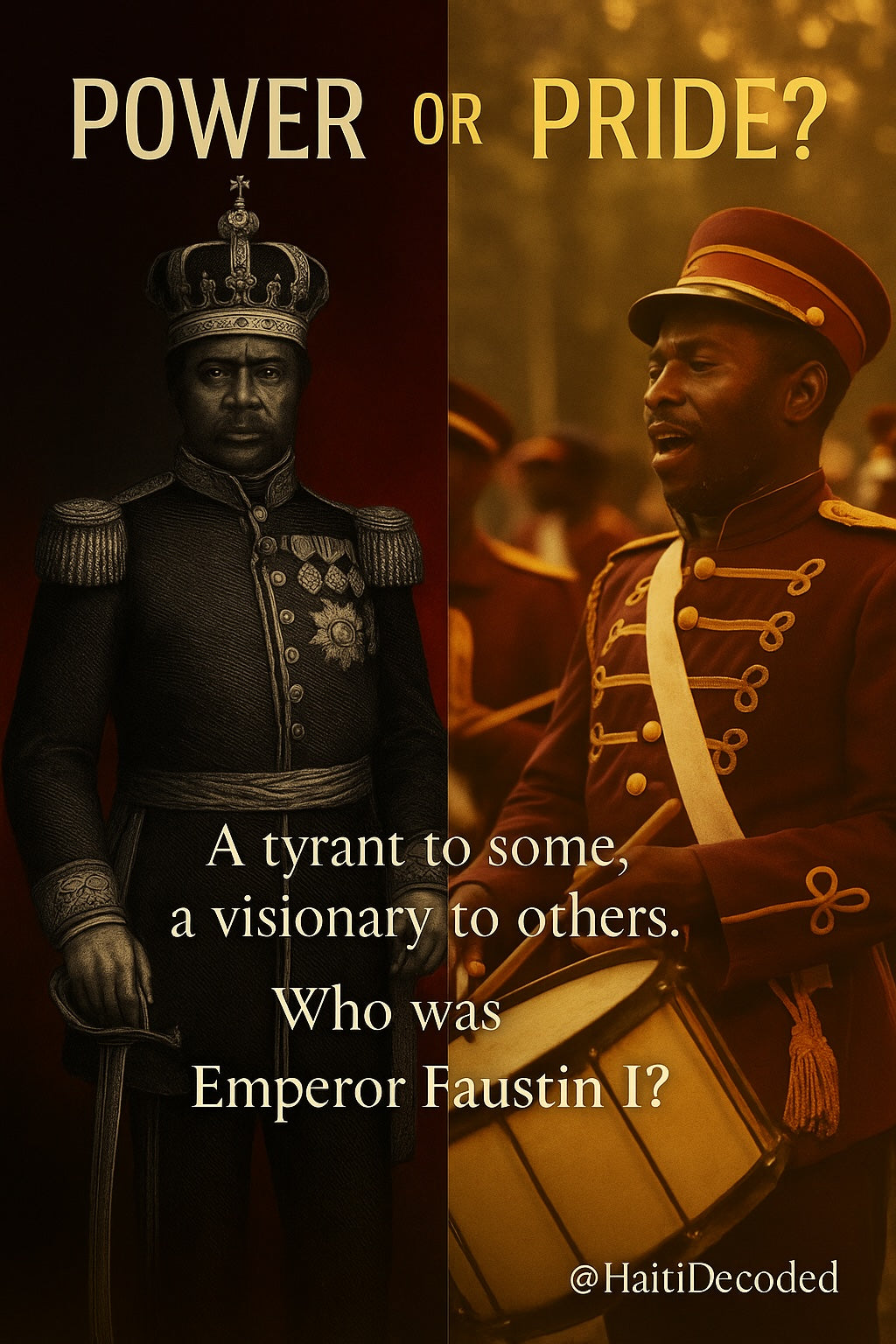When people think of Haitian emperors, they usually stop at Jean-Jacques Dessalines, the fiery revolutionary who declared Hayti’s independence in 1804. Yet nearly fifty years later, Haiti crowned a second emperor, Faustin I, born Faustin Soulouque, whose reign blended pride, power, and pageantry.
Though history often remembers him as ruthless and extravagant- and he was those things- however, the story of Faustin I and the Second Empire of Haiti (1849–1859) reveals much more: a period of cultural ambition, artistic growth, and the ongoing struggle to define what Black sovereignty looked like in a skeptical world.
Who Was Faustin I?
Faustin Soulouque was born enslaved around 1782–1788 and freed during the Haitian Revolution. A disciplined soldier, he fought under several early Haitian governments and eventually became head of the presidential guard under President Jean-Baptiste Riché.
When Riché died in 1847, the Senate found itself divided. Unable to agree on a successor, it turned to Soulouque, an older, modest, and seemingly harmless general who had earned a reputation for loyalty. Many senators assumed he would be easy to control. They were wrong.
Within months, Soulouque reorganized the army, installed loyalists in every region, and built a secret police network. He surrounded himself with a fiercely devoted militia known as “Les Zinglins,” a feared corps of enforcers who ensured his decrees were carried out and his critics silenced. This quiet, underestimated general was no puppet; he was preparing to crown himself emperor.
Why an Empire?
In 1849, after surviving several coup attempts, Soulouque declared himself Emperor Faustin I of Haiti. His coronation, inspired by Napoleon’s but rooted in Haitian ritual, was lavish and symbolic.
By re-establishing an empire, Faustin I wanted to restore the dignity Haiti had lost after decades of civil wars and foreign ridicule. To him, monarchy represented order, stability, and equality among nations, proof that Black leadership could wield power with grandeur.
He created a new Haitian nobility of dukes, counts, and barons; Empress Adélina Soulouque was crowned beside him; and imperial ceremonies fused Catholic and African-derived traditions. In a world where European powers still enslaved Africans, the image of a Black emperor ruling a free nation sent a bold message.
The Empire’s Contributions to People and Culture
Although Faustin I ruled by fear, his regime left unexpected cultural legacies that shaped Haitian identity long after his fall.
1. Patron of Art and Architecture
To project imperial authority, he sponsored painters, sculptors, and architects who decorated Port-au-Prince and Cap-Haïtien with crests, statues, and banners celebrating Haitian heroes. The visual language of the empire — rich reds, golds, and blacks — influenced later Haitian design and national symbolism.
2. Birth of National Music Traditions
Court musicians, military bands, and ceremonial orchestras flourished under his rule. The structured rhythm of these ensembles laid the groundwork for the evolution of konpa and other Haitian styles that blended European instrumentation with African cadence. Music became both state pageantry and popular pride.
3. Re-centering Black Sovereignty
Faustin, I proudly identified Haiti as an African empire in the New World. His proclamations reasserted Black dignity, rejecting the color hierarchies that lingered from colonial times. Titles and medals were granted to soldiers of every shade, reinforcing that “all Haitians are Black,” echoing Dessalines’ 1805 Constitution.
4. Religious and Cultural Fusion
Imperial festivals merged Catholic liturgy with Vodou spirituality, creating uniquely Haitian public rituals. Empress Adélina, said to be a mambo, embodied this synthesis of sacred and imperial authority, reminding Haitians that faith and freedom were intertwined.
The Downfall of the Second Empire
Grand visions came with heavy costs. Faustin I’s repeated military campaigns against the Dominican Republic drained the treasury and demoralized his troops. The extravagant court uniforms, imported jewels, and printed paper money fueled economic collapse.
By 1858, rebellions spread. In January 1859, revolutionary forces from Gonaïves marched on Port-au-Prince. Faustin I abdicated, sought refuge in the French consulate, and sailed into exile in Jamaica. He returned quietly years later and died in 1867.
Legacy: Between Power and Pride
The Second Empire lasted just a decade, but its influence endures. Faustin, I was both tyrant and visionary: he ruled through fear yet awakened a new sense of pride in Haiti’s Black identity. He left behind artistic institutions, musical traditions, and a powerful lesson on how symbolism shapes nations.
To judge him only by his extravagance misses the deeper truth:
The empire was Haiti’s declaration that dignity itself could be a form of resistance.
In the echo of imperial marches, the colors of our flag, and the rhythm of our music, traces of Faustin I’s dream remain a dream of a proud, creative, and sovereign Haiti.
Key Dates
|
1847 |
Faustin Soulouque elected President of Haiti |
|
1849 |
Declares himself Emperor Faustin I — Second Empire founded |
|
1850 |
Formal coronation of Faustin I and Empress Adélina |
|
1859 |
Revolution forces abdication; Empire collapses |
|
1867 |
Death of Faustin I after returning from exile |
Sources & Context
This article draws on Haitian-language oral histories and Creole chronicles that paint a more balanced picture of Faustin I — one that values his cultural influence as much as it critiques his authoritarian rule.
